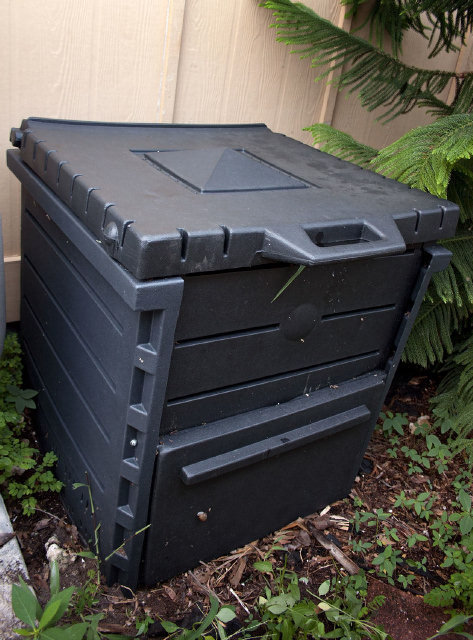Let us praise the fauna of the compost pile

As published in The Miami Herald
Composting is good. Very good, in fact. You get to avoid tossing vegetable scraps in the garbage so the bin doesn’t fill as quickly; there’s less garden debris to dispose of; and the end result is a rich soil amendment you couldn’t even buy.
 |
| A compost bin is a simple box allowing for drainage and air circulation. |
I think all gardeners are clear on the “why” of composting, and I definitely want to go over the “how.” But first, I would like to take a few words to acknowledge the unsung, unappreciated, even reviled decomposers of the compost heap. Let’s explore the micro (and sometimes not so micro) fauna of my rotting heap of apple peels, coffee grounds, eggshells, areca palm fronds, and other compostables.
 |
| You can inspect the layers and stages of decomposition from fresh scraps to soil. |
There’s a definite stratigraphy to my compost: the top layer is intact, not much decomposition here yet. Everything in the top 6 to 8 inches is still recognizable. Here I find lately common garden snails, those ravenous consumers of vegetation. Common Hemidactylus geckos and highly invasive Cuban tree frogs ( Osteopilus septentrionalis) sit at the top of the food chain here and wait for a free lunch of palmetto bugs or other arthropod. I’ve even seen marine toads ( Bufo marinus) loitering nearby.
The next layer, beginning about 8 to 12 inches from the top, is where the action starts. Things get wet and a bit slimy; decay is really setting in. Here are woodlice (aka roly-poly bugs), which are actually terrestrial crustaceans. They are born white, maturing to grayish brown. However I’ve seen fairly large, apparently mature woodlice in my compost that have remained white, perhaps due to lack of exposure to sunlight. Their companions in this stratum consist of lots of common earthworms.
 |
| The Yellow-banded millipede aids in breakdown of organic matter. |
Under this layer is where something recognizable as soil appears, with some stubborn woody remains persisting. This is the haunt of the humble yellow-banded millipede ( Anadenobolus monilicornis). A Caribbean native, it is beneficial in breaking down decaying plant material. Ants and earthworms abound. Here I can scoop out fertile, rich brown compost for my yard and outdoor pots.
I received my compost bin as a gift from my wife. It simply bolted together to form a bottomless box with a lid, air and drainage holes around all sides and the top, and a front door to scoop out finished compost.
You can make one easily from an old plastic garbage container. Just drill holes around the sides for drainage and air, and cut out the bottom so it’s open to the ground and you can lean it back to access the finished compost out the bottom. You could also construct one of wood, which rots too quickly in the subtropics, or make one of wire mesh, but I prefer something closed to encourage the heat necessary to promote decay and kill pathogens and weed seeds.
Start new compost with a layer of brown (carbon-rich) matter like dried leaves, sawdust, etc. Over that layer green (nitrogen-rich) matter like lawn clippings and kitchen scraps (raw vegetation, eggshells, coffee grounds). Add water and mix the layers after a few days. Thereafter, maintaining a carbon-to-nitrogen ratio of about 20 to 1 will speed decomposition, but don’t fret over this. You want to encourage high humidity, but do not want a soaking wet condition that causes an anaerobic situation. In South Florida, a soaking from the hose can be done weekly or so during winter. Generally the only attention your compost will need is the occasional turning over of its contents with a rake, shovel, or small cultivator to encourage aeration. I try to do this weekly, but usually forget.
Besides the animals we can see, there are also fungi and countless microscopic organisms that eat what we throw out. Without them, we would be waist deep in waste. So be grateful to your compost’s herd of decomposers and proud of the little world you’ve created for them.
